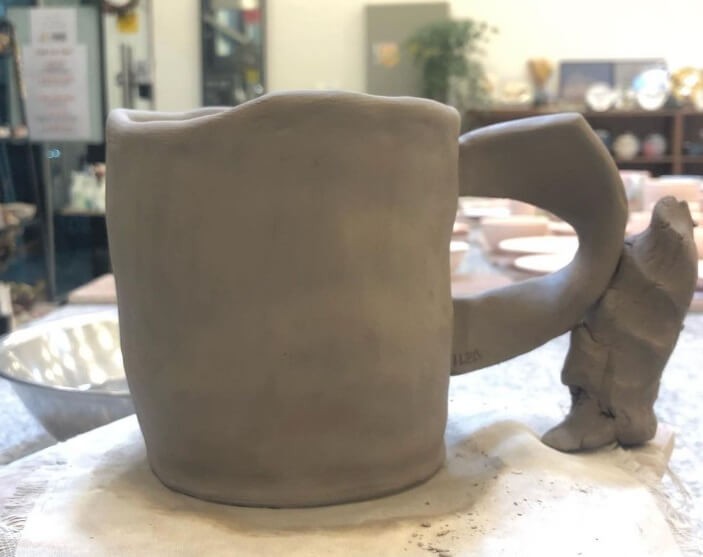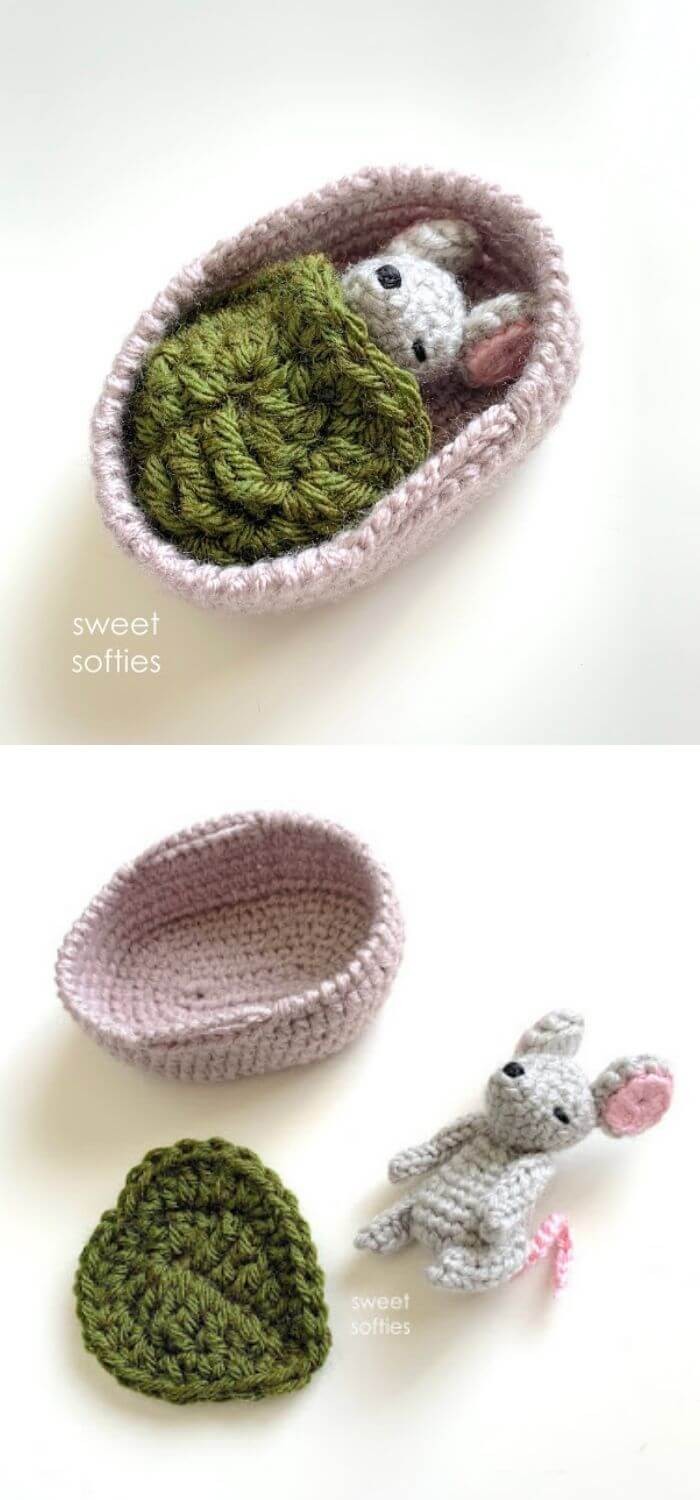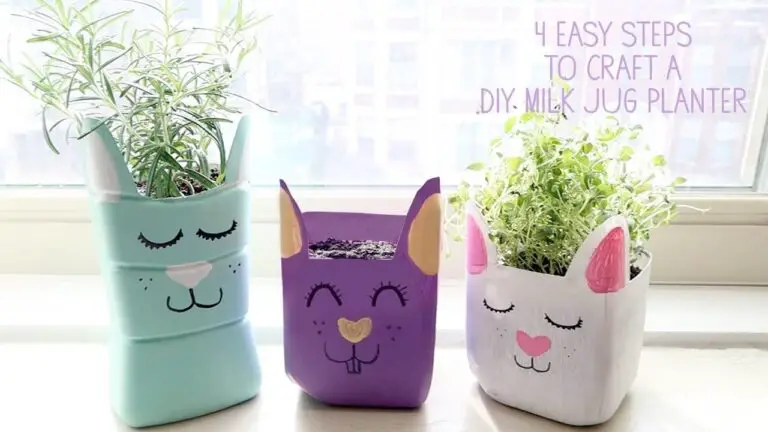20 Alternatives To Granite Countertops Thatll Make Your Kitchen Pop
Looking for a way to give your kitchen a facelift without breaking the bank? Ditching granite countertops might be just the ticket. While granite is a popular choice, it can come with a hefty price tag. But fear not! There are plenty of alternatives that can bring just as much style and sophistication to your space – and they won’t put a dent in your wallet. In fact, we’ve got 20 stunning options to choose from.
From concrete countertops that add an industrial touch to recycled glass surfaces that sparkle like diamonds, the possibilities are endless. So why settle for ordinary when you can have extraordinary? Let’s take a look at some of the most unique and affordable alternatives to granite countertops out there.
Alternatives To Granite Countertops
Concrete.
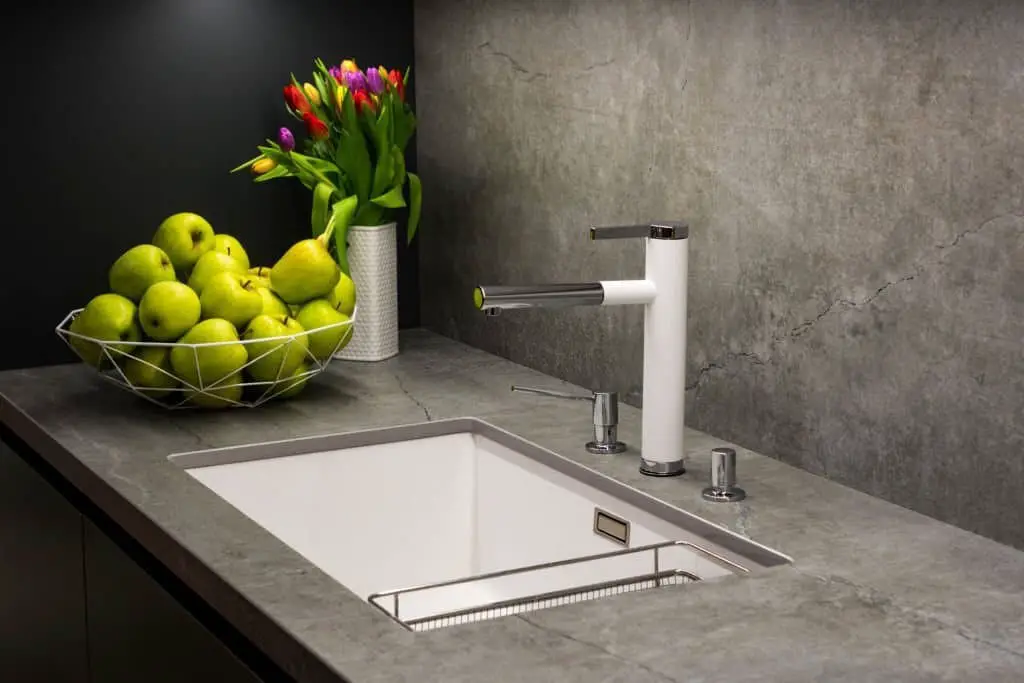
Concrete countertops are an attractive alternative to granite, offering a unique blend of durability and style. One of the primary advantages of concrete is its low maintenance requirement, as it can withstand heavy use without sustaining damage. Additionally, concrete’s versatility allows for easy customization to match any aesthetic, and its affordability makes it a cost-effective option compared to other materials.
However, it’s crucial to hire a professional installer to ensure a high-quality finish. When considering concrete countertops, it’s essential to weigh the pros and cons. On the plus side, concrete is incredibly durable, capable of lasting a lifetime with proper care. It also boasts impressive heat resistance, eliminating concerns about hot pans damaging the surface. Furthermore, concrete can be tailored to suit specific design needs, offering endless possibilities.
On the downside, concrete’s porous nature makes it prone to staining if not properly sealed. Its weight may also necessitate reinforced support for countertop applications. Finally, cracking is a possibility, emphasizing the importance of professional installation to minimize this risk.
Epoxy.
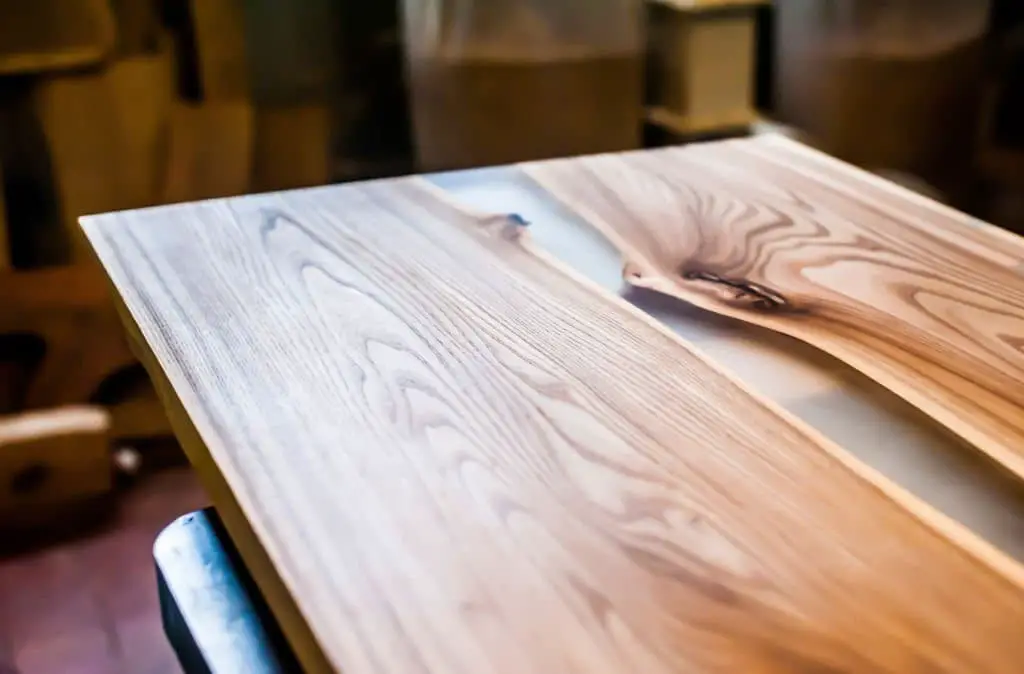
While epoxy is often associated with flooring, it can also be used to create countertops that mimic the look of granite. One of the primary advantages of epoxy is its significantly lower cost compared to granite, making it an attractive option for those on a budget. Moreover, epoxy is remarkably easy to maintain and can be effortlessly repaired if damaged. As a result, epoxy countertops have gained increasing popularity in recent years, offering a practical alternative to granite.
For homeowners seeking a more affordable and low-maintenance countertop solution, epoxy may prove the ideal choice.
Gemstone.
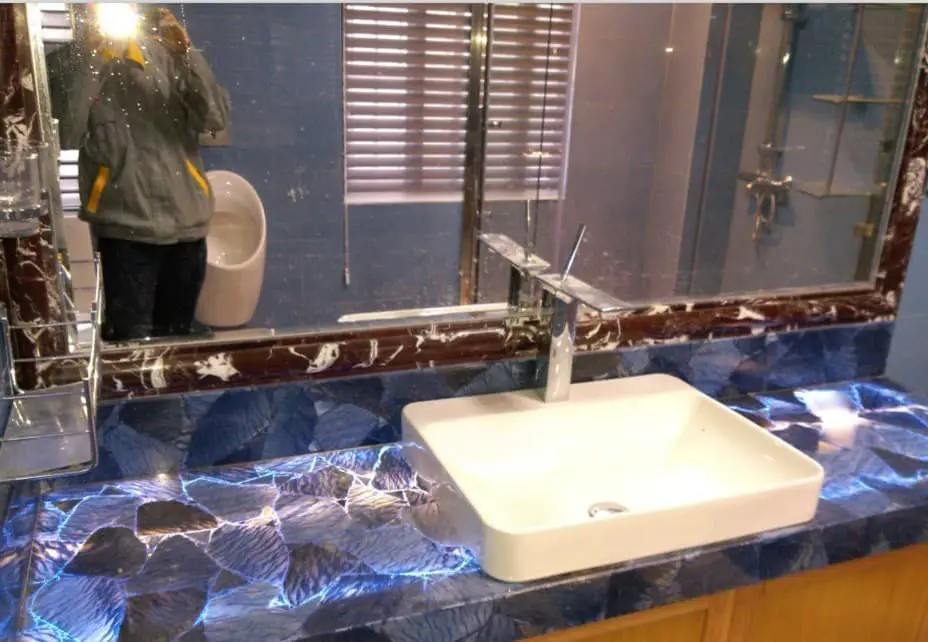
Gemstones, also known as igneous rocks, are created through the slow cooling and solidification of lava or magma. This process allows minerals to arrange themselves in a crystalline structure, giving gemstones their unique characteristics. One of the primary reasons gemstone countertops are sought after is due to their exceptional durability and ability to withstand high temperatures without sustaining damage.
While these benefits make gemstone an attractive option for homeowners, it’s essential to consider the potential drawbacks: cost and installation complexity.
Laminate.
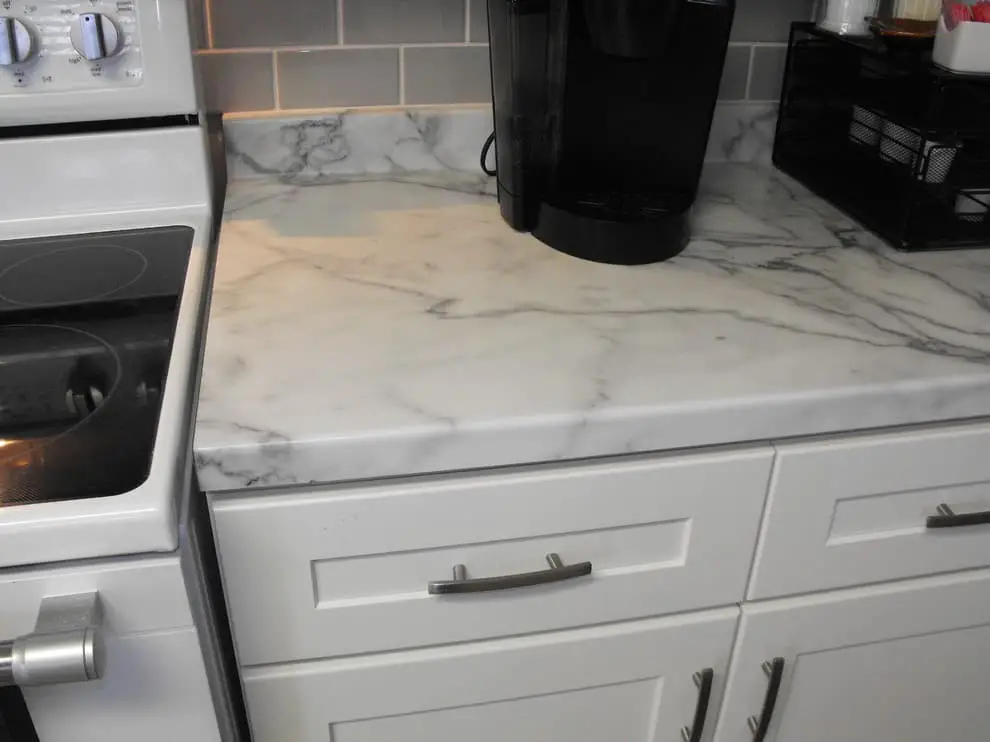
Laminate, a synthetic material designed to mimic the appearance of stone, offers a cost-effective and hassle-free installation process. Its construction involves layering plastic sheets together using heat and pressure, resulting in a non-porous surface that is resistant to stains and scratches. The material also boasts an extensive range of colors and patterns, making it a versatile option for homeowners.
Limestone.
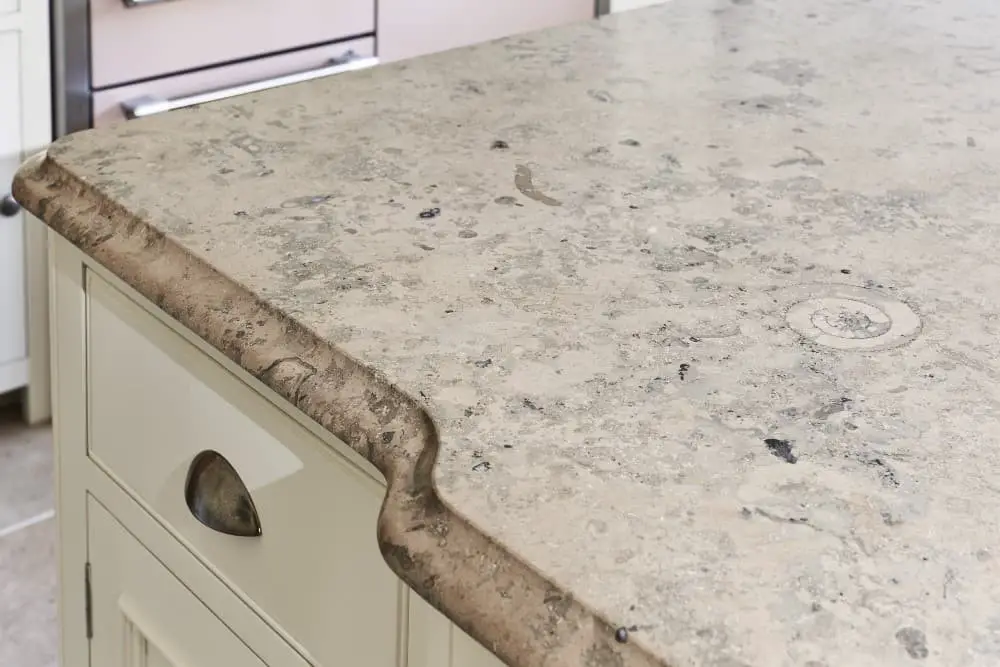
Limestone, a sedimentary stone renowned for its natural fissure, makes it an excellent selection for kitchen countertops. Its exceptional heat and scratch resistance, combined with its inherent beauty, have earned it widespread popularity among homeowners seeking a low-maintenance yet visually striking surface.
This versatile stone is available in a range of hues, including white, black, gray, and beige, as well as varied textures such as polished, honed, and brushed.
Its adaptability has contributed to its enduring appeal, making it a go-to choice for many home renovators.
While limestone’s durability and ease of care make it an attractive option for kitchen countertops, it is crucial to acknowledge that it is a softer stone prone to scratches or damage if not properly maintained. As such, homeowners must take necessary precautions to ensure the longevity of their limestone surfaces.
Marble.
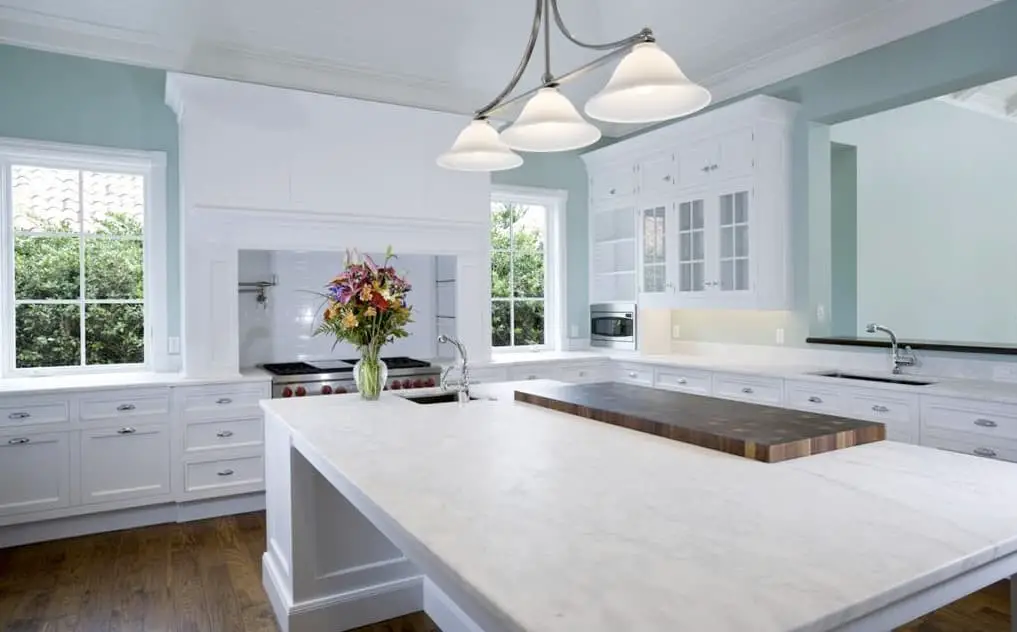
While granite may be a popular choice for countertops, marble offers a classic look that can bring elegance to any kitchen or bathroom. Its versatility in terms of color options also makes it an attractive alternative. When polished, marble can achieve a high-shine finish, making it a stunning focal point in any room. In the kitchen, marble’s heat resistance is a significant advantage. However, its soft nature means it can be prone to scratching and staining.
To maintain its beauty, marble countertops require regular sealing and cleaning, ensuring they remain a stylish addition to your home.
Onyx.
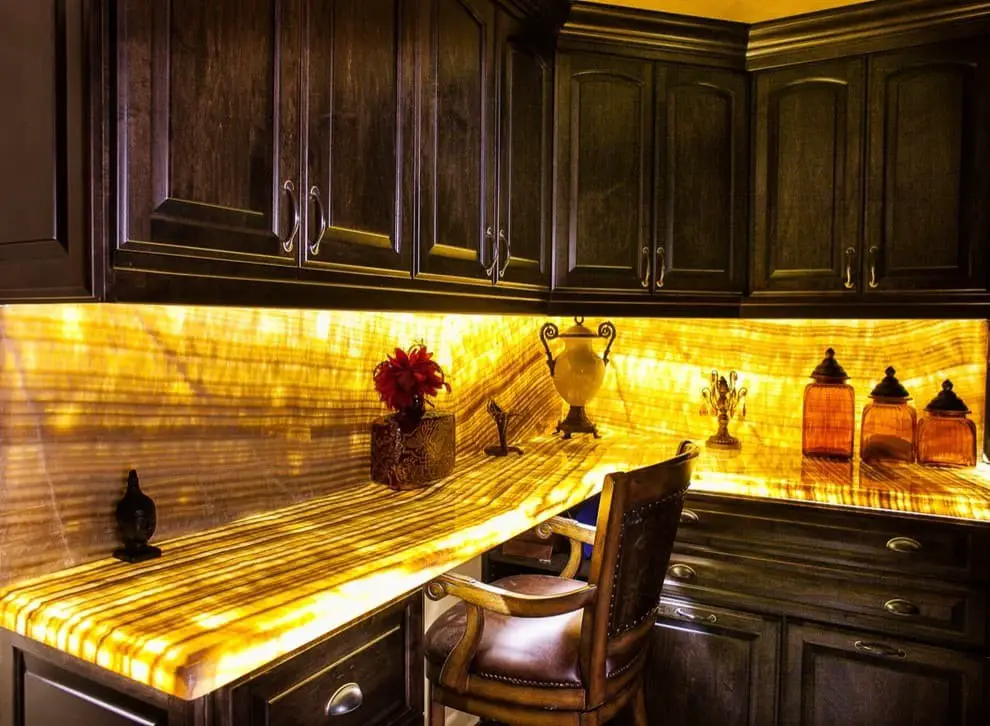
For centuries, onyx has been a staple in jewelry and decorative items, prized for its unique beauty and versatility. Its rich history is reflected in the numerous countries where it’s mined, including Brazil, China, India, and Pakistan. While onyx may not have the same luxurious reputation as granite, it offers an attractive alternative for countertops due to its relative affordability and intricate carvability.
Furthermore, the stone’s wide range of colors – from pure white to deep black – provides endless design possibilities. However, it’s essential to note that onyx is a softer stone than granite, making it more prone to scratches and stains.
Quartz.
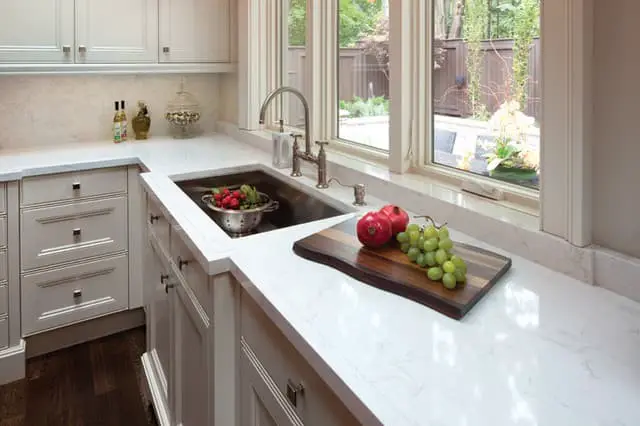
Quartz countertops have become increasingly popular among homeowners due to their unique blend of natural and man-made components. This distinctive aesthetic appeal stems from the combination of quartz crystals and resins. Not only does quartz boast a visually appealing design, but it also offers exceptional durability. Its heat-resistant and scratch-resistant properties make it an ideal choice for busy kitchens where accidents can happen.
Additionally, quartz is non-porous, ensuring that spills and stains won’t seep into its surface as they might with other countertop materials. With a wide range of colors and styles available, finding the perfect quartz countertop to suit your personal taste is a breeze.
Quartzite.
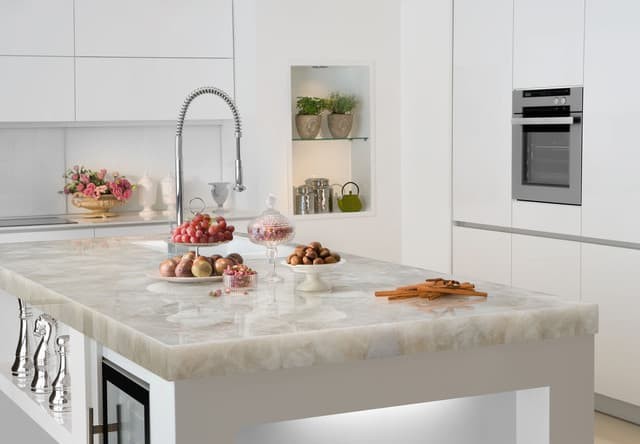
Quartzite, a natural stone alternative to granite, is gaining popularity due to its exceptional durability. Its hardness surpasses that of granite, making it an excellent choice for countertops that can withstand the test of time. Moreover, quartzite’s heat resistance ensures that hot pans and cookware won’t leave any unsightly marks or damage your countertop.
The versatility of this natural stone is further highlighted by its diverse color palette and pattern range, allowing homeowners to select a style that seamlessly integrates with their kitchen’s aesthetic.
Recycled glass.
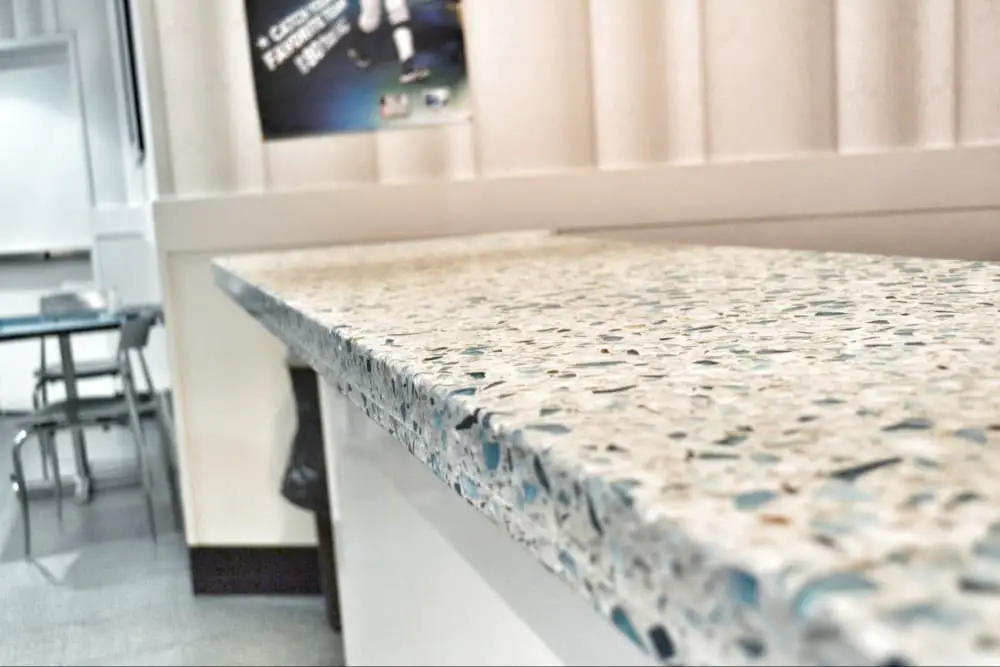
When it comes to sustainable countertop options, recycled glass stands out as a beautiful and eco-friendly choice. Made from reclaimed glass products like bottles and other containers, this material is not only environmentally friendly but also boasts impressive durability. One of its greatest advantages is its nonporous surface, which makes it highly resistant to stains and bacteria.
Plus, recycled glass countertops come in a range of vibrant colors, allowing you to find the perfect hue to match your kitchen’s unique style.
Recycled paper.
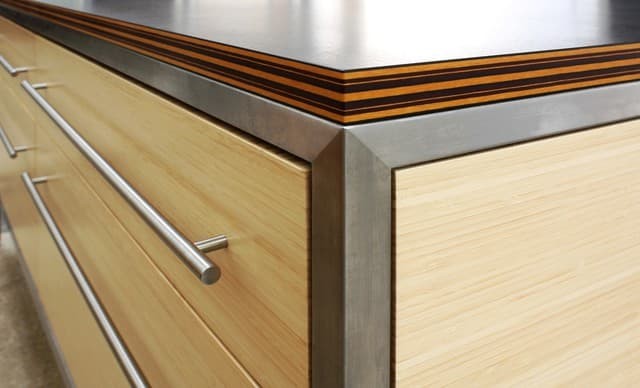
If you’re seeking an eco-friendly alternative to traditional stone surfaces like granite, recycled paper countertops might just be the perfect solution. Made entirely from post-consumer waste paper, these innovative counters boast impressive durability, along with resistance to heat and stains. What’s more, they come in a diverse range of colors and patterns, allowing homeowners to add a unique touch to their kitchens or bathrooms.
And let’s not forget the added bonus – recycled paper countertops are significantly more affordable than granite, making them an attractive option for those looking to balance aesthetics with sustainability.
Sintered stone.
Sintered stone, a composite material composed of quartz, pigments, and resins, undergoes high-pressure and heat processing to form a solid, non-porous surface. This unique process enables sintered stone to exhibit several advantages over traditional granite options. Firstly, it boasts enhanced resistance to stains and scratches, making it a low-maintenance choice for homeowners. Additionally, the absence of sealing requirements simplifies the cleaning process.
Furthermore, sintered stone’s versatility is reflected in its diverse color palette and design options, which can convincingly replicate the appearance of materials like granite, marble, or concrete, offering consumers greater flexibility when selecting a material for their project.
Slate.
A metamorphic rock of origin is shale-type sedimentary rock composed of clay or volcanic ash that has undergone low-grade regional metamorphism. This process transforms the original material into a unique rock type characterized by its ability to split into thin layers, known as foliation. Slate’s distinctive property is reflected in its diverse range of colors, including black, gray, greenish-gray, purple, red, blue, brown, and yellow.
Its versatility has made it a popular choice for various applications, such as roofing, flooring, staircases, fireplace hearths and mantels, billiard tables, blackboards, and even slate pencils.
Soapstone.
Soapstone, a metamorphic rock primarily comprising talc, derives its name from its distinctive soapy texture and appearance. With a rich history of use, soapstone has been a popular choice for centuries due to its exceptional heat resistance, durability, and aesthetic appeal. Its versatility allows it to be used for countertops, sinks, and stovetops alike.
In terms of color, soapstone typically exhibits a range from black to gray or greenish-gray hues, although rare instances of white or pink tones can also be found. As a relatively soft stone, it is easily workable and lends itself well to carving. Furthermore, its non-porous nature makes it resistant to stains and bacterial growth. For those seeking an alternative to granite that still offers durability and beauty, soapstone presents a compelling option.
If you’re considering incorporating soapstone into your countertop design, it’s essential to consult with a professional to ensure this unique material aligns with your home’s specific needs.
Solid Surface.
A blend of acrylic and polyester resins typically goes into the creation of engineered stone, commonly referred to as solid surface. This man-made material’s versatility lies in its ability to be molded into any shape, making it an attractive option for countertops that feature curves or unconventional designs. The non-porous nature of solid surface also contributes to its popularity, as it effectively repels stains and simplifies the cleaning process.
While not without its limitations, solid surface does have a tendency to scratch or gouge more readily than other materials, and its heat-resistance is compromised, making it less suitable for kitchens where scorching hot pans are frequently placed.
Stainless Steel.
One notable substitute for granite is quartz, which shares many of its advantages. This material boasts impressive resistance to heat, scratches, and stains, making it a practical choice for busy kitchens. Additionally, quartz surfaces are simple to maintain and clean. However, one drawback is the higher cost compared to other options.
Tile.
Tile has been a timeless choice for centuries, and its popularity endures. This versatile material offers a vast array of colors, styles, and sizes, ensuring that you can find the perfect match for your kitchen’s aesthetic. Moreover, tile is remarkably durable, capable of withstanding intense heat and scratches, making it an excellent option for busy kitchens.
However, one drawback to tile countertops is their finicky nature when it comes to cleaning – grout can be a challenge to keep free from stains. Furthermore, tile surfaces are susceptible to chips and cracks, which may not appeal to those seeking a low-maintenance solution.
Travertine.
Travertine countertops derive their unique charm from being crafted from sedimentary rock. This natural appearance is further enhanced by the variety of colors available, allowing homeowners to easily find a perfect match for their kitchen. Furthermore, travertine’s heat resistance and durability make it an excellent choice for busy kitchens where spills and splatters are common.
Although travertine is a porous material, its porosity can be mitigated through regular sealing, which helps prevent stains from forming.
Wood.
A timeless favorite among countertop materials, wood has been a staple in kitchens for centuries. Its enduring popularity stems from its exceptional durability and low maintenance requirements. One of the key advantages of wood countertops is their ability to withstand water damage through staining or sealing. Additionally, wood is surprisingly heat-resistant, making it an excellent choice for areas around the stove where high temperatures are common.
Zinc.
Zinc’s exceptional durability allows it to thrive in high-temperature environments, making it a premier material for countertops. Moreover, its non-porous nature prevents stains and spills from penetrating the surface, unlike porous materials like granite. This unique property makes zinc an attractive option for those seeking low-maintenance countertops.
The versatility of zinc countertops is another significant advantage.
Available in a range of colors and finishes, you can easily find one that harmonizes with your kitchen’s aesthetic. Some manufacturers even offer zinc countertops designed to mimic the appearance of granite, providing a convincing alternative for homeowners who’ve grown tired of traditional stone countertops.
FAQs
What is the best alternative to granite?
While granite remains a popular choice for kitchen and bathroom design, there are numerous alternatives that can bring a unique touch to these spaces. Among the most sought-after options are marble, quartz, soapstone, and concrete – each boasting its own distinct characteristics. Before making a decision, it’s essential to weigh the pros and cons of each material. Ultimately, the ideal alternative will depend on your specific needs and personal style.
For those seeking a classic, timeless aesthetic, marble is an excellent choice. This natural stone has been utilized for centuries in iconic structures around the world. Its versatility is reflected in its wide range of colors, allowing you to find the perfect hue to complement your décor. Moreover, marble’s heat resistance makes it an ideal selection for kitchen countertops.
What countertop is better than granite?
While granite remains a top choice for many homeowners, other countertop materials are gaining popularity. One such option is quartz, a man-made material comprised of natural quartz crystals. Its exceptional hardness makes it an excellent choice for countertops, resistant to scratches and wear. Additionally, its non-porous nature renders it impervious to stains, making cleanup a breeze.
Another popular alternative is soapstone, a natural stone with centuries-old roots in kitchen and bathroom design. Notably heat-resistant and durable, soapstone countertops can develop a unique patina over time, which some find aesthetically pleasing.
Is Corian cheaper than granite?
Corian countertops tend to be more budget-friendly than granite due to several factors. For one, Corian has a lower production cost compared to granite. Additionally, Corian is usually supplied in larger sheets, resulting in fewer seams and reduced labor costs during installation. Furthermore, the lighter weight of Corian means that installation costs are often lower than those for granite, which can be a significant advantage for homeowners on a budget.
Is quartz cheaper than granite?
While the final cost of quartz and granite countertops may vary depending on specific factors like the type and quality of the materials, as well as installation expenses, it’s generally true that quartz options tend to be pricier than their granite counterparts. The disparity in price stems from the unique characteristics and advantages of each material.
Do epoxy countertops look cheap?
While it’s common to assume that epoxy countertops are dull and unattractive, they actually offer a modern aesthetic that can elevate the style of your kitchen or bathroom. Moreover, their exceptional durability and ease of cleaning make them an excellent choice for homeowners who want low-maintenance surfaces. As an added benefit, epoxy countertops are often more budget-friendly compared to other materials, making them an attractive option for those looking to save on their countertop project.
Is Silestone cheaper than granite?
When it comes to comparing Silestone to other countertop options, several factors come into play. The type of granite being compared and the company providing the material both influence the answer. Generally speaking, Silestone tends to have a slightly higher price point than granite. For those seeking a more affordable alternative to Silestone, quartz countertops are definitely worth considering.
Quartz is often priced lower than Silestone yet still offers many desirable qualities, such as durability and low maintenance requirements. Regardless of which material you choose for your countertops, it’s essential to secure multiple quotes from different suppliers before making a decision. This approach ensures you’re getting the best possible price.
Is quartzite better than granite?
Granite, a natural stone with centuries-old roots in both interior and exterior applications, boasts impressive durability. Its resistance to scratches, heat, and stains has made it a popular choice. Quartzite, on the other hand, is a relatively new material crafted from quartz sandstone. While it shares many qualities with granite, it surpasses it in terms of durability and stain-resistance. The question remains: which material reigns supreme?
Ultimately, the answer hinges on individual needs and preferences. For those seeking an exceptionally resilient option capable of withstanding intense wear and tear, quartzite may be the more suitable choice.
Conclusion
A few fantastic options for replacing granite countertops at a budget-friendly price are now on the table. From quartz to marble, soapstone, and concrete, each material offers an attractive alternative that just might have you rethinking your stance on granite altogether.
Related Posts
For those seeking a creative and fulfilling career, becoming a kitchen and bath designer can be an exciting pathway. With a keen eye for detail and understanding of spatial layouts, this profession requires a combination of artistic flair and technical expertise. To get started on your journey, let’s explore some key considerations. From optimizing space in Singaporean kitchens to top tips for renovating yours, we’ll cover it all.
Whether you’re looking to give your kitchen a fresh new look or seeking inspiration for your own design project, this article will provide valuable insights and expert advice. So, if you’re ready to turn your passion into a career, let’s dive in!

